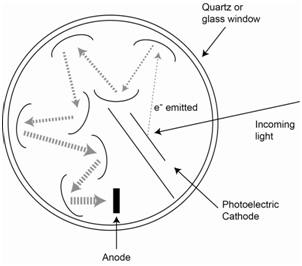1.3C: Detectors
- Page ID
- 111359
Explain how a photomultiplier tube works. What are any advantages or disadvantages of a photomultiplier tube?
A photomultiplier tube is commonly used to measure the intensity of ultraviolet and visible radiation. The measurement is based initially on the photoelectric effect and then on the amplification of the signal through a series of dynodes (Figure \(\PageIndex{15}\)). The initiation of the detection process involves radiation striking the surface of a photoactive surface and dislodging electrons. Electrons dislodged from this surface are accelerated toward the first dynode. This acceleration is accomplished by having the first dynode at a high voltage. Because of the acceleration, each electron released from the photoactive surface dislodges several electrons when it strikes the surface of the first dynode. Electrons emitted from the first dynode are accelerated toward the second dynode, etc. to eventually create a cascade of electrons that causes a large current.

The advantage of the photomultiplier tube is its ability to measure relatively small amounts of electromagnetic radiation because of the amplification process that occurs. A disadvantage is that any spurious signal such as stray radiation is also amplified in the process, leading to an enhancement of the noise. The noise can be reduced by cooling the photomultiplier tube, which is done with some instruments. A caution when using a photomultiplier tube is that it must not be exposed to too high an intensity of radiation, since high intensity radiation can damage the photoelectric surface.
Photomultiplier tubes are useful for the measurement of radiation that produces a current through the photoelectric effect – primarily ultraviolet and visible radiation. It is not useful for measuring the intensity of low energy radiation in the infrared and microwave portion of the spectrum.
Describe a photodiode array detector. What advantages does it offer over other detection devices?
A photodiode array detector consists of an array or series of adjacent photosensitive diodes (Figure \(\PageIndex{16}\)). Radiation striking a diode causes a charge buildup that is proportional to the intensity of the radiation. The individual members of the array are known as pixels and are quite small in size. Since many pixels or array elements can be fit onto a small surface area, it is possible to build an array of these pixels and shine dispersed light from a monochromator onto it, thereby measuring the intensity of radiation for an entire spectrum. The advantage of the photodiode array detector is the potential for measuring multiple wavelengths at once, thereby measuring the entire spectrum of a species at once. Unfortunately, photodiode arrays are not that sensitive.

A more sensitive array device uses a charge-transfer process. These are often two-dimensional arrays with many more pixels than a photodiode array. Radiation striking pixels in the array builds up a charge that is measured in either a charge-injection device (CID) or charge-coupled device (CCD).


